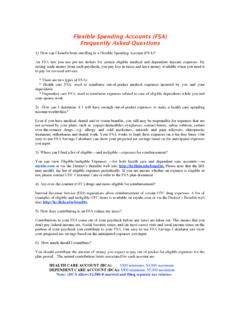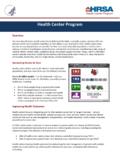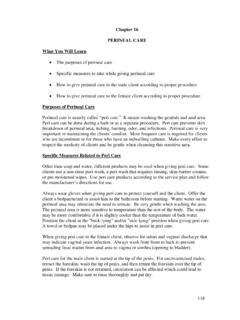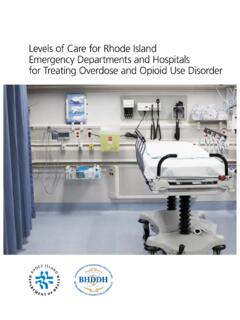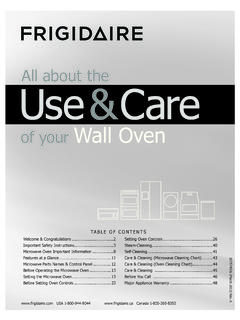Transcription of Nonurgent Use of Hospital Emergency Departments
1 600 MARYLAND AVE SW SUITE 550 WASHINGTON, DC 20024-2512 TEL: FAX: THE NONPARTISAN CENTER FOR STUDYING HEALTH SYSTEM CHANGE (HSC) IS AFFILIATED WITH MATHEMATICA POLICY RESEARCH Nonurgent Use of Hospital Emergency Departments Statement of Peter Cunningham, Senior Fellow and Director of Quantitative Research Center for Studying Health System Change (HSC) BEFORE THE SENATE Health, Education, Labor and Pensions Committee Subcommittee on Primary Health and Aging Hearing on Diverting Non-urgent Emergency Room Use: Can It Provide Better care and Lower Costs? May 11, 2011 Statement of Peter Cunningham, , Center for Studying Health System Change, before the Senate, Health, Education, Labor and Pensions Subcommittee on Primary Health and Aging, May 11, 2011 1 Chairman Sanders, Sen.
2 Paul and members of the Subcommittee, thank you for the invitation to testify about use of Hospital Emergency Departments for Nonurgent health problems. My name is Peter Cunningham, and I am a researcher and director of Quantitative Research at the Center for Studying Health System Change (HSC). HSC is an independent, nonpartisan health policy research organization affiliated with Mathematica Policy Research. HSC also is the research arm of the nonpartisan, nonprofit National Institute for Health care Reform, a 501(c) (3) organization established by the International Union, UAW; Chrysler Group LLC; Ford Motor Company; and General Motors to conduct health policy research and analysis to improve the organization, financing and delivery of health care in the United States ( ).
3 I and other HSC researchers have conducted a number of studies documenting the increase in the use of Hospital Emergency Departments , including for Nonurgent health problems, and the problems of crowding at some Emergency Departments (EDs). We have examined how these trends affect and are affected by larger developments in the health care system, the reasons why people use Emergency Departments for minor ailments, and the potential for hospitals to shift some of their Emergency department visits to primary care providers in the community. Our goal at HSC is to inform policy makers with objective and timely research on developments in the health care system and the impact on people. We do not make specific policy recommendations. Our various research and communication activities may be found on our Web site at There has been much concern over the past decade about what many believe is a national crisis of crowded and overloaded Hospital Emergency Departments and the consequences for patient care and the ability of EDs to respond to both individual and mass-casualty emergencies.
4 Contributing to the problem of ED crowding is a substantial increase in Emergency department utilization among the population, which is often attributed to growing use of Emergency Departments for Nonurgent health problems. As a result, many policy makers and health care providers believe that it is essential to shift Emergency department use for Nonurgent health problems to primary care providers in the community to relieve crowded Emergency Departments , lower the costs of care and improve the quality of care . My testimony today will make the following key points: Emergency department use has increased substantially over the past 15 years, mostly because of increased use by people with private insurance and other health coverage. While Emergency department crowding is often attributed to the uninsured, their use of Emergency Departments is considerably less than privately insured people.
5 Increases in Emergency department visits by the uninsured account for only a small share of the overall increase in Emergency department volumes. Few Emergency department visits are truly Nonurgent , according to the most credible national data. Most ED visits are neither clearly Nonurgent nor truly emergencies. Determining whether these visits could be shifted to primary care settings in the community is difficult because the appropriate use of the Emergency department for health problems often depends on factors other than their urgency, including the time of day and day of the Statement of Peter Cunningham, , Center for Studying Health System Change, before the Senate, Health, Education, Labor and Pensions Subcommittee on Primary Health and Aging, May 11, 2011 2 week when care is needed, the availability of other providers in the community such as freestanding urgent care centers, and the ability to get same-day appointments with primary care physicians.
6 Increases in Emergency department visits reflect a more general increase in the demand for ambulatory care , and it should be emphasized that physician office visits have increased at an even higher rate than Emergency department visits. As office-based physicians struggle with growing practice capacity constraints, some of the excess demand is spilling over into Hospital EDs. For their part, some patients prefer going to the Emergency department even when they have a primary care physician because Emergency Departments are open 24 hours a day, seven days a week. Many Hospital Emergency Departments are expanding capacity to accommodate the increased demand, as well as to increase revenues from resulting inpatient admissions and procedures, particularly for privately insured and Medicare patients.
7 Far from perceiving Emergency Departments as money losers, most hospitals have little financial incentive to discourage Emergency department use by privately insured and Medicare patients including for Nonurgent health problems which could complicate efforts to shift some Nonurgent visits to more-appropriate community settings. Despite recent increases in utilization, Hospital Emergency Departments represent a relatively small part of the health care system in terms of both utilization and costs. Reducing the use of EDs for Nonurgent health problems may generate much lower cost savings than is commonly assumed. However, because Medicaid enrollees have by far the highest per person use of Hospital Emergency Departments , the potential cost savings to the Medicaid program could be more substantial.
8 The Evolving Role of Hospital Emergency Departments Hospital Emergency Departments are a critical and indispensable component of the health care system. While their traditional mission is to provide trauma and Emergency services for people in imminent danger of losing their life or suffering permanent damage to their health, the role of Emergency Departments has evolved over the past several decades. EDs are on the front lines of communities preparedness efforts and responses to natural disasters, other mass-casualty events, and public health emergencies arising from outbreaks of influenza and other communicable diseases. And Emergency Departments have become the true provider of last resort for uninsured people and other patients who are unable to afford other medical providers in the community, largely as a result of the 1986 federal Emergency Medical Treatment and Labor Act (EMTALA) that requires hospitals to provide Emergency screening and stabilization services regardless of patients ability to pay.
9 Along with the fact that Emergency Departments are often the only medical facilities in a community that are open 24 hours a day, seven days a week, true emergencies comprise only a relatively small share of visits to Emergency Departments . Today, Hospital Emergency Departments are a major source of primary health care in the community, treating a broad range of health problems that include many visits for minor ailments and other Nonurgent conditions. Statement of Peter Cunningham, , Center for Studying Health System Change, before the Senate, Health, Education, Labor and Pensions Subcommittee on Primary Health and Aging, May 11, 2011 3 Use of Emergency Departments Still Relatively Rare Americans made a total of 124 million visits to Hospital Emergency Departments in 2008, the latest year for which data are available from the National Hospital Ambulatory Medical care Survey (NHAMCS) the most authoritative and cited source of information on Emergency department utilization (see Table 1).
10 1 Compared with other forms of ambulatory care use, however, use of Hospital Emergency Departments is relatively rare, accounting for only 10 percent of all ambulatory care visits to medical providers. By contrast, Americans made 956 million visits to physician offices in 2008 representing 80 percent of all ambulatory care visits and 110 million visits to Hospital outpatient Departments . Emergency department use is also much less frequent than physician office visits on a per capita basis. There were 41 Emergency department visits for every 100 Americans in 2008, compared to 320 physician office visits for every 100 Americans. About 84 percent of Americans visited a physician s office in 2007, compared to 23 percent who visited a Hospital Emergency department.

